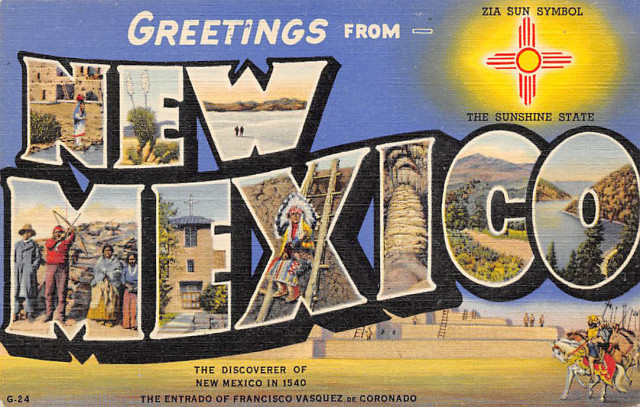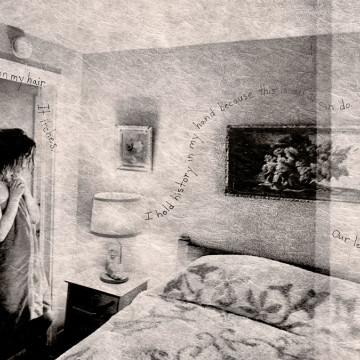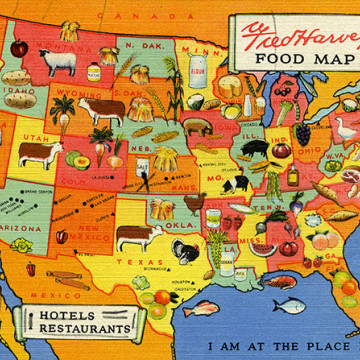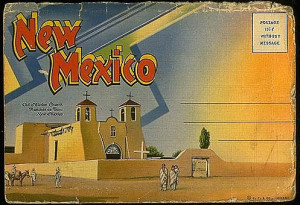
Greetings from New Mexico, 1940, postcard; Curt Teich Postcard Archive Collection, Newberry Library
Postcards, Tourism, & History
Everybody Hates a Tourist
German author Hans Magnus Enzensberger wrote, “Tourists, following the handbook, experience ancient Rome as a historical zoo where they can look into the eye of the beast of history without danger or punishment.” His “A Theory of Tourism” lays bare the competing tensions of this thing we call “a tourist.” (1) They seek to escape their world, but wish to remain comfortable. They travel for pure leisure, but pack their itinerary with sights to see. They want to experience a place, but only to the extent that a destination’s inconvenient realities do not affect them. Tourism, as we know it today, is only a few centuries old, a product of the Industrial Revolution, capitalism, and a long-standing campaign by labor groups to make available to common people time to pursue activities other than work. The Blue Swallow by EveNSteve is a monumental black-and-white photographic artwork with handwritten text that tells a fictional story about what it means to visit New Mexico and “look into the eye of the beast of history.”
Tourism arrived in New Mexico with the Atchison, Topeka, and Santa Fe Railroad in 1879. For the first time, people could travel in relative convenience to the Land of Enchantment. Local entrepreneurs developed businesses to cater to travelers and to promote a region as a destination. Artists and writers played a key role in shaping the tourist narrative of New Mexico. Lillian Whiting wrote in her 1906 travel guide to the American Southwest, “New Mexico is the scene of surprises. Traditionally supposed to be a country that is as remote as possible from the accepted canons of polite society; that is also an arid waste whose temperature exceeds the limits of any well-regulated thermometer,—it reveals itself instead as a region whose temperature is most delightful, whose coloring of sky and atmosphere is often indescribably beautiful, and whose inhabitants include their fair proportion of those who represent the best culture and intelligence of our country.” Clinton P. Anderson in the forward to the Federal Writers Project’s 1942 New Mexico: A Guide to the Colorful State writes, “New Mexico today represents a blend of three cultures: Indian, Spanish, and Anglo-American. The Indian, in his pueblo, still carries on the religious ceremonies of his ancestors, while in the village nearby the descendants of the Spanish and Mexican conquerors swirl rhythmically to the strains of folk songs long since brought from old Spain and Mexico. To the beat of the Indian tom-tom and the gay rhythms of the Spanish dance, there is added the roar of the air transport and the sweep of the transcontinental streamlined train. This is New Mexico today: a people united under one sovereignty, but representing a background of four centuries under Indian, Spanish, Mexican, and American cultures.” (2) Full of inaccuracies and hyperbole, these are less descriptions of New Mexico as they are promises to tourists about what they will find if they choose to spend their leisure time and tourism dollars in the state.
Over the last 150 years, New Mexico has worked hard to invest in its tourism industry. It set aside places of natural beauty as parks. It preserved historic sites. It even curbed its architecture to meet the expectations of tourists. As Tourism Sante Fe explained, “Triggered by efforts in 1912 to boost tourism in Santa Fe, the Pueblo Revival period ushered in a resurgence of Pueblo-Spanish and Territorial architectural styles, with contoured adobe walls, flat roofs, vigas or beams and nichos, or small arches carved into the walls for displaying objects.” (3)
From “A Colorful State” to “New Mexico True”, New Mexico’s business interests vigorously marketed the land, people, and culture to outsiders. Anthropologist Nelson H.H. Graburn writes, “Tourists leave home because there is something that they want to get away from, and they choose to visit a particular place because they believe that they will experience something positive there that they cannot easily experience at home.” (4) Tourism marketing tends to focus on the tourist with little concern for the subject of their gaze. Often people are compelled to perform a place for those visiting it. Restaurateur Fred Harvey paid Native Americans to perform staged indigeneity and marketed the people of New Mexico as “exotic” and “primitive.” He invited people to sell their pottery and crafts on blankets in front of his restaurant. (5) Historian Susanne Berthier-Foglar wrote about the impact this industry had on people:
“The situation appears crassly colonial as it seems that the experience of the Others’ culture was limited to sampling a primitivist experience before retreating to the comfort of Western ‘Anglo-Saxon’ hospitality. However, the long-term effects of tourism on tribal communities have to be viewed in a more favorable light. The early decades of the 20th century have not witnessed the destruction of tribal culture. Pueblo and Navajo artists have produced goods for the market. However, from craftspeople they have often become artists. In the formative years of the market they were often counseled by traders so as to adapt their creations to consumer tastes and market trends. Indigenous objects were adapted to the needs of the buyers, large ollas (jars) would become table lamps, carpets were produced in the colors in fashion in mainstream decorating, small and portable objects were produced to fit into travelers’ suitcases.” (6)
Berthier-Foglar goes on to document how such activities thwarted the Bureau of Indian Affairs’ attempts to assimilate native people. She ultimately concludes, “In the case of Northern New Mexico, tourism has participated in the survival of Indianness and also in the economic integration of the tribes. Even in the presence of a tourist economy, with strong economic ramifications into tribal economies, the communal life of insiders takes precedence over the tourist activity.”
Tourism is a vital economic driver of New Mexico’s economy, employing nearly 100,000 people and generating over $10 billion in annual sales in 2019 when 38 million people visited the state. (7) The state operates the New Mexico Tourism Department which promotes the state and researches visitor trends and economic impacts. They work to place stories about New Mexico in the media. No research is done on how New Mexicans feel about those stories. This came to a head in April 2021 when the Department released a new video that used a quote from artist Georgia O’Keeffe. “When I got to New Mexico, that was mine. As soon as I saw it, that was my country. I’d never seen anything like it before, but it fitted to me exactly. It’s something that’s in the air, it’s just different. The sky is different, the stars are different, the wind is different.” The Santa Fe Reporter captured the reaction of Felicia Garcia (Chumash) to the video. “The messaging within this campaign is representative of a broader effort to overwrite Indigenous connections to place, which is a function of the ongoing colonial project. Colonial ideologies related to land and land ownership—such as manifest destiny, terra nullius and Western notions of private property—continue to harm Indigenous people. Indigenous place names, landmarks, stories, boundaries or lack thereof have been overwritten by romanticized US mythologies like this one.”
The Department’s online brand resource hub states, “We are all travelers. We seek what is true and avoid fabricated reality. The question is, where do we find authenticity? Where can we have immersive experiences that combine adventure with culture?...Upon arrival and throughout their time here, our visitors discover authentic experiences, from the cultures that have lived here for centuries, to the unique and varied landscape, and our genuine and friendly people. New Mexico isn’t about plastic replicas, papier-mâché attractions, or contrived adventures.” A search of the website finds no mention of the words colonization, racism, Manifest Destiny. How authentic of an experience could they be offering?
The state’s long, complicated history of serving indigenous people to tourists continues today. The Department declared 2018 “Summer of the Mother Road” and released a campaign to promote Historic Route 66. “When traveling Route 66 in its entirety, Illinois to California, New Mexico is the first spot where the scenery becomes dramatically different,” Tourism Cabinet Secretary Rebecca Latham said in the press release. “The fact that you can still find authentic cultural experiences among any of the 10 tribes and pueblos along the Route make New Mexico a standout for anyone craving a memorable summer trip.”(8)
The press release continued, “Among the historic locations the film features is Tucumcari’s Blue Swallow Motel, whose unique nostalgic rooms and bright neon lights set it apart from other accommodations along the route. ‘It’s the only one that’s still operating on New Mexico Route 66,’ said owner Kevin Mueller, speaking of the motor court design made up of small rooms separated by single car garages. Today the Blue Swallow stands much like it did when it was built in 1939, with the original awnings, windows, doors, fixtures and tile work still in place. ‘This is what Route 66 is all about. The unique experience’.”
The Blue Swallow Motel opened in 1942 with a ten-room motor court and cafe. Lillian Redman, who took over the motel in the 1950s when the original owners died in a plane crash, saw the operation as something of a ministry to travelers. She handed each person who checked in a Benediction that read in part, “Because this motel is a human institution to serve people, and not solely a money-making organization, we hope that God will grant you peace and rest while you are under our roof.” The Blue Swallow Motel, like many businesses along Route 66 in New Mexico, suffered when Interstate 40 opened in the late 1960s. Subsequent owners have maintained the place as a historic site and working motel. It was placed on the National Register of Historic Places in 1993.
READ OR HEAR LILLIAN REDMAN’S BENEDICTION
The Blue Swallow Motel embodies the romantic mid-century American tourism that helps shape New Mexico. Motorists arrive, spend the night, and continue on their journey the next day. The landscape and the people of New Mexico are a backdrop for their adventure and exist as undeveloped, secondary characters in a theme park of Americana. This is often how we treat history, choosing to focus on lone figures and single moments rather than complex, inconvenient narratives that may cause us to reflect on past atrocities. EveNSteve flip this script and consider what it would mean to fully sit with the bonfire of history.
In the song, Common People, English rock band Pulp sings the line, “everybody hates a tourist” as comment on the dynamics when upper class British people socialize with members of the working class. Bemoaning tourists is part of tourism. Enzensberger notes that it speaks to the uneasy, symbiotic relationship between visitors and the visited. There is a difference between a tourist who is ignorant, entitled, and exploitive and one who moves through a place with respect, openness, and genuine curiosity. For better or for worse, going to new places is how we learn about the world and other people and that knowledge has the capacity to foster empathy and understanding.
In The Blue Swallow, EveNSteve use an in-camera collage technique; fragments of imagery assemble like a memory. The text gives voice to the solitary figure who is thinking about what it means to be a white tourist in New Mexico and confront the legacies of colonization, racism, Manifest Destiny that shape those histories. A privilege of whiteness is the freedom to choose amnesia over memory, to deny the history or accept it. The figure in The Blue Swallow wrestles with her options: to hold the history; to slip out of her skin; to perform guilt or shame; or to retreat into the cloak of tourism. In the end, she hands the choice to us.
Share Your Thoughts: What do you think? SEND AN EMAIL and we will share it with the artist, curator, and organization.
SOURCES
1 Enzensberger, Hans Magnus (1996). A theory of tourism. (G. Gemünden & K. Johnson, Trans.). New German Critique, 68, pp. 117-135. (Original work published in August 1958.)
2 Miller, Joseph (1942). New Mexico: A guide to the colorful state (Henry G. Alsberg, Ed.). Hastings House.
3 Tourism Santa Fe (n.d.). Santa Fe Architecture. Tourism Santa Fe. website
4 Graburn, Nelson H. H. (2018). Secular ritual: A general theory of tourism. In Sharon Bohn Gmelch & Adam Kaul (Eds.), Tourists and tourism: A reader (3rd ed.) (pp. 17-28). Waveland Press.
5 Weigle, Marta (1989). From desert to Disney World: The Santa Fe Railway and the Fred Harvey Company display the Indian Southwest. Journal of Anthropological Research, 45(1), 115-137.
6 Berthier-Foglar, Susanne (2010). Les Indiens pueblo du Nouveau-Mexique. PU de Bordeaux.
7 Tourism Economics (2019). Economic impact of visitors in New Mexico, 2019. Tourism Economics.
8 New Mexico Tourism Department (2018, April 27). New Mexico declares the “Summer of the Mother Road”. New Mexico True. website
Greetings Traveler:
In ancient times, there was a prayer for “The Stranger Within our Gates.” Because this motel is a human institution to serve people, and not solely a money-making organization, we hope that God will grant you peace and rest while you are under our roof.
May this room and motel be your “second” home. May those you love be near you in thoughts and dreams. Even though we may not get to know you, we hope that you will be as comfortable and happy as if you were in your own house.
May the business that brought you this way prosper. May every call you make and every message you receive add to your joy. When you leave, may your journey be safe.
We are all travelers. From “birth till death,” we travel between the eternities. May these days be pleasant for you, profitable for society, helpful for those you meet, and a joy to those you know and love best.
Sincerely yours,
Lillian Redman (owner of the Blue Swallow Motel from 1958-1998)





